Which Shoes Are Perfect for Cycle Ride For Men & Women
Excerpt
Looking for the perfect shoes for cycling? Whether you’re a daily commuter, weekend rider, or fitness cyclist — choosing the right pair matters. In this guide, we break down the best cycling shoes for both men and women based on comfort, grip, breathability, and budget. From casual bike rides to long-distance pedals, find out which shoes truly support your cycling journey.
Why Discount Shoes Can Be a Smart Buy or a Risky Mistake
Cycling is more than just pedaling—it’s comfort, control, and confidence.
And believe it or not, your shoes play a big role in all three.
Many riders—both men and women—use regular shoes for cycling, thinking any pair will do. But from my experience helping countless buyers in the store, I’ve seen the difference the right cycling shoe can make. Whether it’s a short daily ride, a long-distance commute, or an off-road trail, your feet need the right support, grip, and comfort.
So, what are the best shoes for cycle rides?
This guide will walk you through it all—
✅ From casual sneakers to pro-level cycling shoes
✅ Real advice based on what customers actually buy and love
✅ Tips for daily riders, fitness cyclists, and beginners
✅ And smart buying ideas for every budget
What You Should Look for in Cycling Shoes
When you’re riding a bicycle — whether it’s for work, fitness, or fun — your shoes do more than just cover your feet. They affect your balance, pedal control, foot comfort, and even riding safety. Choosing the wrong pair can lead to slippery pedals, sore feet, or even accidents.
So let’s break down the key features you should always check before buying cycling shoes — whether you’re a beginner or ride regularly.
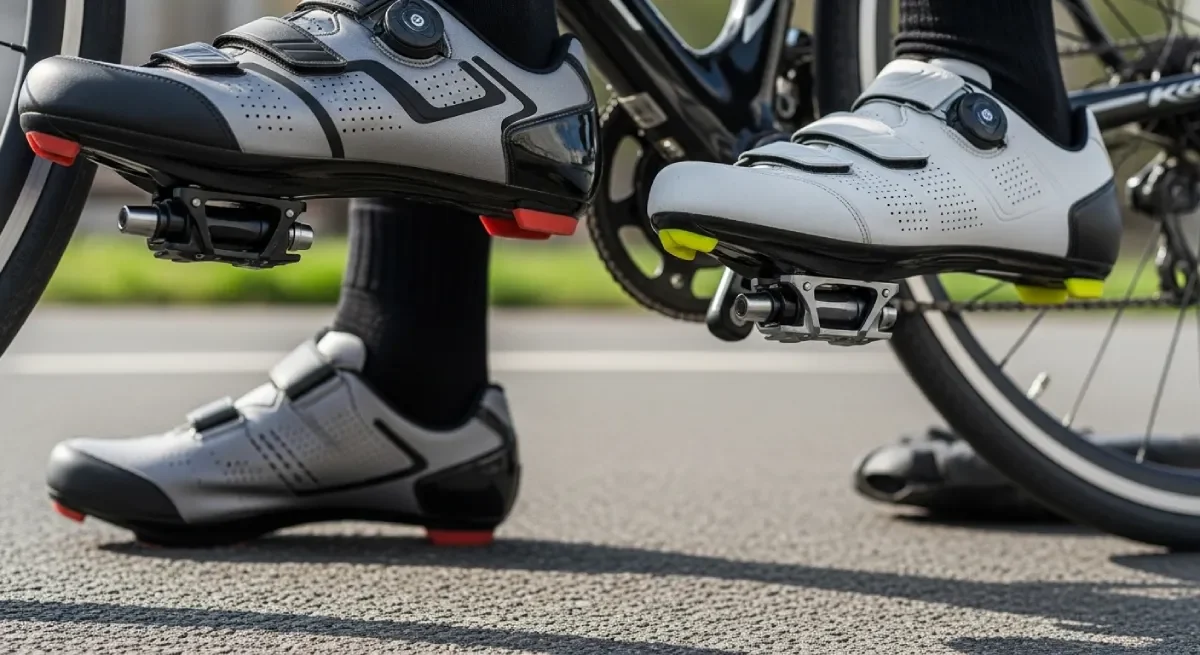
1. Good Grip on the Sole
Why It Matters:
When you’re pedaling, your shoes are the only connection between your body and the bike. If your soles don’t grip the pedals properly, your foot may slip — especially during fast rides, uphill climbs, or sudden stops. This can break your rhythm, reduce speed, and even lead to painful accidents.
What to Look For:
- Rubber outsoles with textured tread
- Anti-slip patterns under the shoe
- Flat soles that make better contact with platform pedals
- Shoes specifically marked for “flat pedal cycling” or “grip outsole”
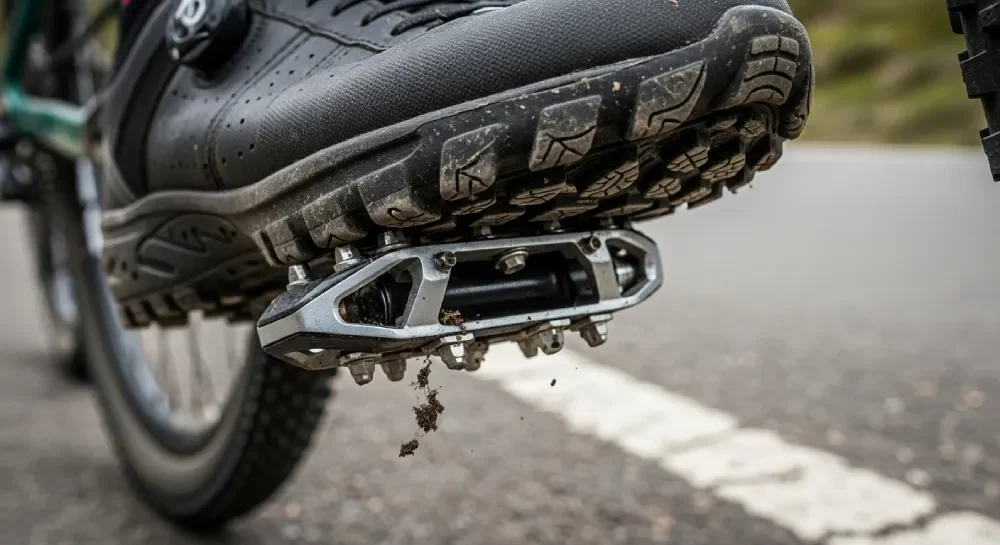
🚫 Avoid:
Overly soft running or walking shoes — they’re great for foot flex but not energy transfer.
Expert Note:
In-store, we recommend people press the shoe’s arch with their hand. If it bends too easily, it won’t give strong pedal support.
2. Firm but Flexible Sole
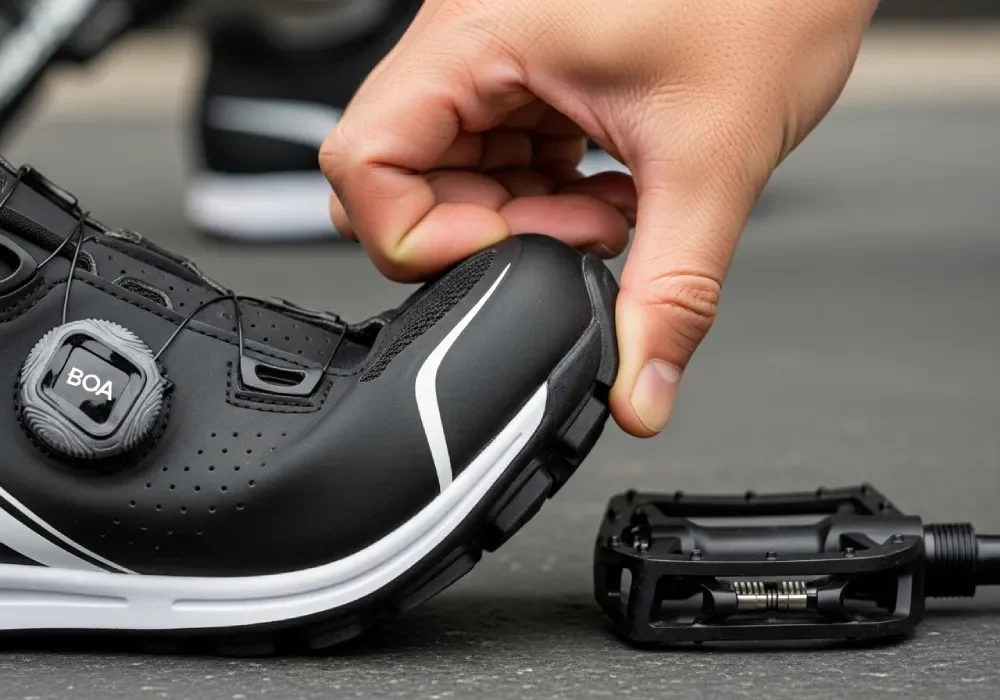
Why It Matters
Cycling involves repetitive pressure on the ball of your foot. A sole that’s too soft (like in running shoes) will absorb your pedaling energy, making you work harder for less output. On the other hand, a rock-hard sole might cause pain during long rides.
What to Look For:
- Medium-stiff midsoles (EVA, TPU or nylon blend)
- A little bend near the toes, but not floppy
- Labeled “sport sneaker,” “flat pedal MTB shoe,” or “skate-style sole”
🚫 Avoid:
Smooth-soled dress shoes, fashion sneakers, or foam-bottom shoes — these often slide off metal pedals.
Store Experience Tip:
I’ve seen many first-time buyers walk in with casual canvas sneakers and return later complaining of foot slippage. A grippy sole changes the game completely.
3. Breathable Upper Material
Why It Matters:
When you’re cycling, your feet generate more heat than you’d expect — especially during long commutes, uphill rides, or under the blazing summer sun. In hot and humid cities like Dhaka, Lagos, or Manila, lack of ventilation can quickly turn your shoes into a sauna. Without proper breathability, your feet may get sweaty, smelly, and uncomfortable — even leading to rashes, blisters, or fungal infections in worst cases.
A breathable shoe keeps airflow consistent, helping to release heat and moisture. This means cooler, drier, and fresher feet — even after hours of cycling.
What to Look For in a Breathable Cycling Shoe:
✅ Mesh Upper Material – Thin, layered mesh fabric promotes air circulation without compromising structure.
✅ Ventilated Panels or Side Perforations – Small holes or mesh zones on the side/tongue boost airflow inside the shoe.
✅ Moisture-Wicking Liner – Inner lining that pulls sweat away from your skin, helping keep feet dry.
✅ Labels to Check – Look for product descriptions with terms like:
• Breathable upper
• Aerated panels
• Ventilated design
• Moisture-wicking mesh
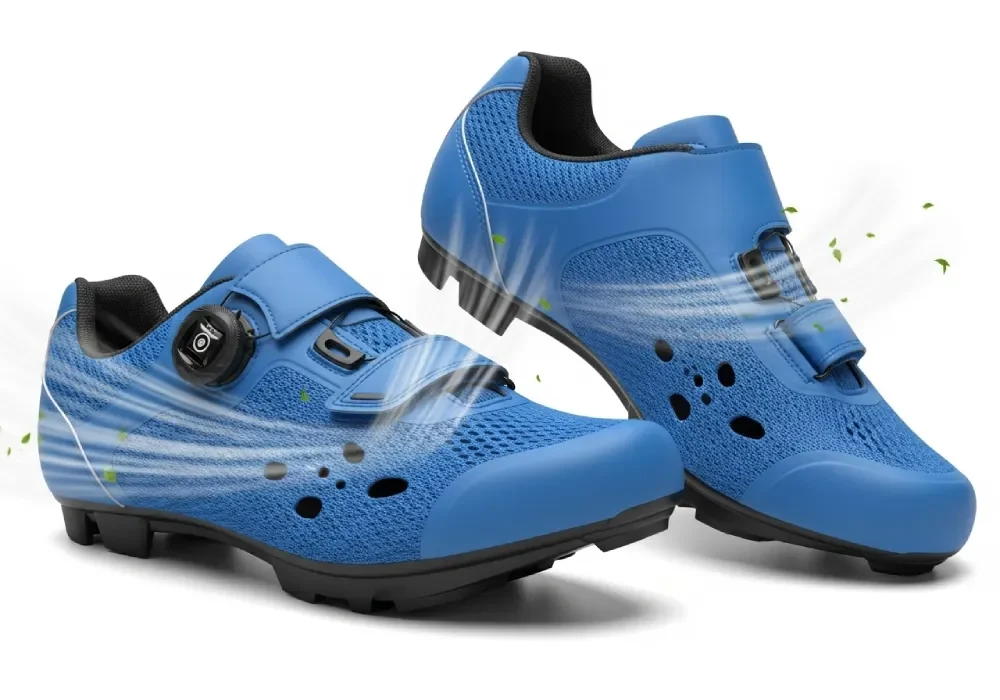
Best For
✔️ Urban riders cycling in traffic-heavy cities
✔️ Delivery workers riding all day in warm climates
✔️ Fitness cyclists or commuters who wear shoes for long hours
✔️ Anyone riding in spring/summer heat
Real-World Store Tip:
Avoid shoes made with heavy plastic, vinyl, or full synthetic leather — unless they have visible ventilation holes or mesh zones. These materials may look stylish, but they trap heat and sweat inside the shoe.
Pro Tip:
If your feet tend to overheat easily, choose low-cut cycle shoes with breathable uppers and moisture-wicking socks — a powerful combo for all-day comfort.
4. Lightweight Design
Why It Matters:
When you’re cycling, especially on long routes or daily commutes, every extra gram on your feet slowly drains your energy. Heavy shoes can put unnecessary strain on your leg muscles, reduce pedaling efficiency, and leave you feeling tired even before your ride is done. Lightweight shoes help you pedal faster with less fatigue — which means more comfort, longer rides, and better performance.
Whether you’re commuting through city traffic, riding through a park, or delivering parcels on a bicycle, light shoes give you an edge. They reduce the drag on your feet and feel almost invisible when you’re in motion.
Ideal Weight Range:
- Under 350g per shoe is ideal for regular cyclists, office commuters, and city riders.
- Performance cycling shoes often weigh around 250g and still provide strong support and structure.
- Anything heavier than 400g may start to feel bulky after 20–30 minutes of continuous riding.
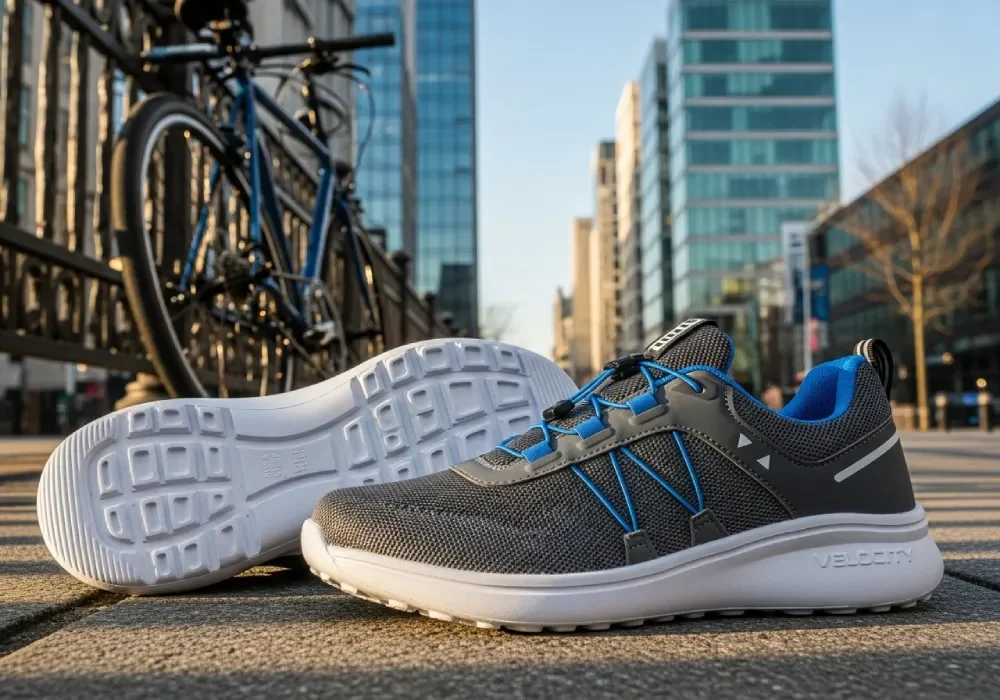
Look For:
- Lightweight EVA midsoles – These provide good cushioning without adding weight.
- Mesh or woven fabric uppers – Reduces material weight and improves airflow.
- Low-profile designs – Shoes with sleek shapes and minimal bulk, often labeled as “urban cycling” or “commute-ready.”
- Flexible heel collar & tongue – These help reduce pressure points and make the shoe easier to walk in post-ride.
🚶♂️ Don’t Forget:
Lightweight shoes aren’t just great on the bike — they’re helpful off it too. If you need to walk into your office, visit a friend, or grab a snack after your ride, bulky shoes can feel like a burden. A lightweight pair keeps you mobile, comfortable, and stylish without needing a shoe change.
5. Snug Fit (Not Loose or Tight)
Why It Matters
Fit is everything when it comes to cycling shoes. If your shoes are too loose, your feet will keep sliding forward or sideways — reducing pedaling power, creating friction, and leading to painful blisters or instability on the bike. On the other hand, if the shoes are too tight, you might feel pressure on your toes, arch, or instep — especially in hot weather, when feet naturally expand due to heat.
What to Aim For:
- Heel and Midfoot Lockdown: Your heel should feel snug and locked in, with no up-and-down movement.
- Slight Toe Room: Your toes should not touch the front of the shoe; a finger-width gap is ideal.
- Adjustable Closure Systems: Look for:
- Traditional laces (good for flexible fit)
- Velcro straps (quick and simple adjustments)
- Boa dials (found in advanced models; for precise micro-adjustments)
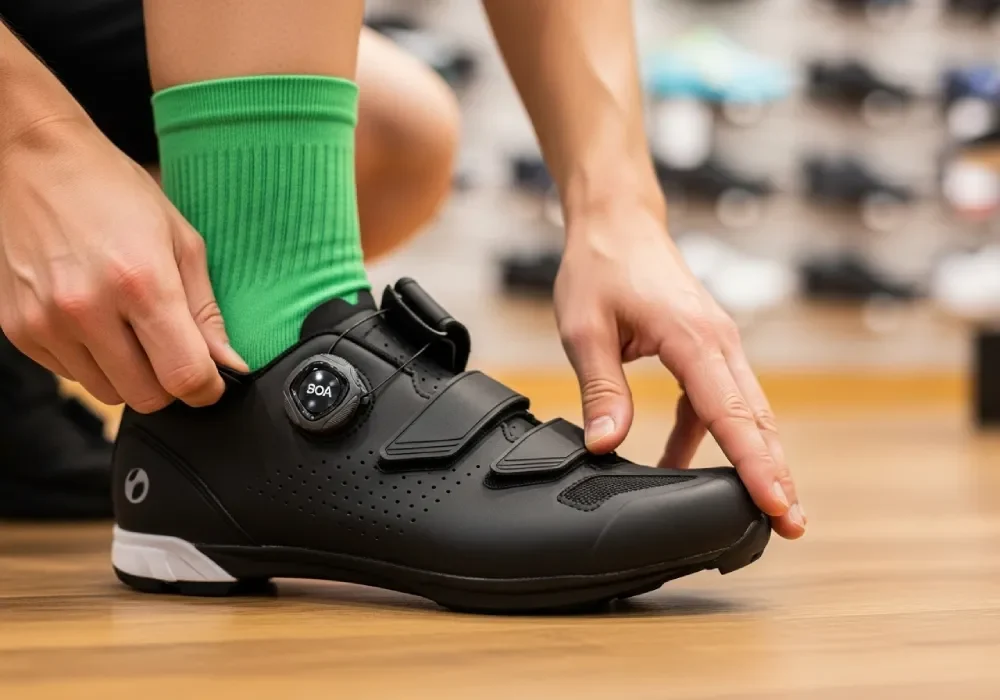
Try Before You Ride:
Don’t just try the shoes barefoot. Always wear the same type of cycling socks you use during rides. Walk around the store — if you feel any tight spots, rubbing, or numbness, that shoe isn’t your fit.
🛒 In-Store Pro Tip:
We always recommend trying on cycling shoes in the afternoon or evening. Why? Because by that time of day, your feet are slightly swollen — just like they will be during a long bike ride. This helps you avoid buying a pair that feels okay in the morning but painfully tight after 30 minutes of pedaling.
6. Protection from Road Impact (Optional but Helpful)
Why It Matters
When you’re cycling on bumpy roads, gravel paths, village trails, or under-construction streets — your shoes face more than just pedaling pressure. Small stones, loose gravel, broken glass, or even sudden impacts from hard terrain can hurt your feet. Without protection, you risk bruised toes, stubbed front foot, or even long-term foot discomfort — especially if you’re riding daily.
This is even more important if you:
- Commute on rough roads
- Ride mountain trails or countryside paths
- Work as a delivery rider stepping down often
- Use one pair of shoes for both riding and walking
Cycling shoes with extra protection act as armor for your feet. While these features might not seem essential for city riders, they’re a game-changer for those facing unpredictable road conditions.
Protection Features to Look For
✅ Reinforced Toe Caps
Acts like a shield for your toes — prevents injuries from rocks or accidental bumps.
✅ Padded Heel Collars
Adds extra comfort and reduces ankle stress during long rides or rough terrain walks.
✅ Reflective Strips
Bonus safety feature if you ride early in the morning or late at night — makes you visible to cars and pedestrians.
✅ Durable Upper Overlays (Rubber or TPU)
Protects against water splashes, road dust, and general wear-and-tear — especially in rainy or dusty environments.
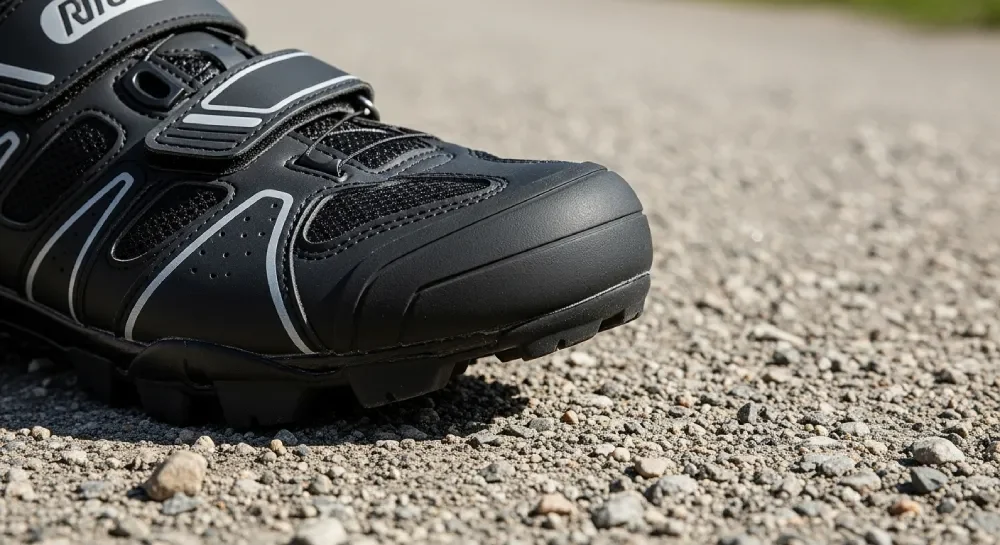
Real-World Tip
Many delivery riders and mountain bikers choose shoes with thick toe guards and rugged overlays. They may not look as sleek, but they last longer and give better protection for daily abuse.
Use Case Fit
These protective features are best suited for:
- Delivery workers stepping onto mixed terrain regularly
- Cyclists on rural or hilly paths
- Long-distance riders where weather or terrain may suddenly change
- Those who don’t want to switch shoes for off-bike walking
Final Advice
Protection features might add a little weight, but they add a lot more durability and comfort. So if your ride is anything but smooth, consider this an investment in your foot safety.
Best Types of Shoes for Cycling Real Examples
Not all cycling shoes are created equal — and not all riders have the same needs. Some people ride to work, some ride for fitness, and some just enjoy an evening cycle. That’s why there’s no “one-size-fits-all” shoe. Based on years of store experience and real customer feedback, here are the top types of shoes perfect for cycling, along with real-world examples you can buy.
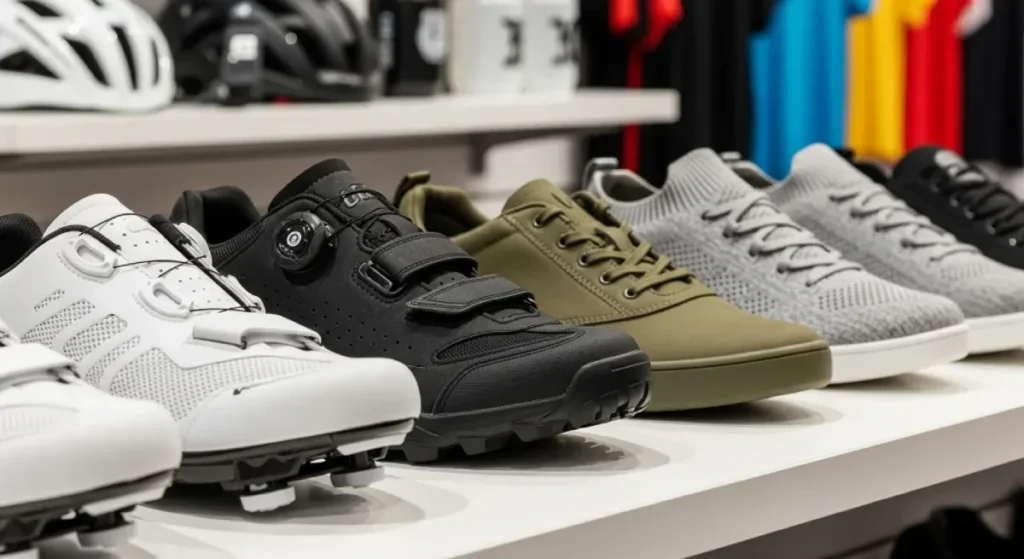
1. Sport Sneakers with Good Grip
Best for: Daily commuters, casual riders, beginner cyclists
These are regular sports shoes with rubber outsoles, decent cushioning, and breathable mesh uppers. They’re not made specifically for cycling, but they work well for short rides and light use.
Why they’re good:
- Easily available
- Comfortable for walking too
- Budget-friendly
- Grippy enough for flat pedals
Real Examples:
- Adidas Duramo
- Puma Flyer Runner
- Nike Flex Experience
🛍️ Store Insight: Many customers who ride 5–10 km daily prefer sports sneakers for their comfort and flexibility.
3. Stylish Trainers / Casual Sneakers
Best for: Short rides, fashion-conscious riders, casual use
For those who love biking around the block or just a quick coffee ride, stylish trainers offer comfort and looks. They’re not built for performance, but they get the job done for short, easy trips.
Why they’re good:
- Lightweight
- Fashion-friendly
- Comfortable for walking
Real Examples:
- Puma Carina
- H&M Casual Trainers
- Converse Chuck Taylor (rubber sole version)
👟 Store Experience: Many women and young customers choose these shoes for short-distance cycling with friends or errands.
5. Hybrid Walking-Cycling Shoes
Best for: People who ride and walk frequently (delivery workers, commuters) These shoes are built to perform on a bike and also stay comfortable when walking. A bit of a mix between sport shoes and cycling shoes.
Why they’re good:
- Dual-purpose
- Often have stiff midsoles with walking comfort
- Ideal for mixed-use
Real Examples
- Shimano CT500
- DZR Jetlag Nero
- Specialized Recon ADV
2. Flat Pedal MTB-Style Shoes (Skate Look, Grippy Sole)
Best for: Mountain biking, off-road trails, regular riders
These shoes are designed with sticky rubber soles, reinforced toe caps, and better grip for rough or uneven trails. Perfect for riders who use flat pedals and don’t want to clip in.
Why they’re good
- Maximum pedal grip
- Stronger sole for power transfer
- Durable for tough conditions
Real Examples
- Five Ten Freerider (Adidas)
- Crankbrothers Stamp Lace
- Ride Concepts Hellion
🛠️ Expert Tip: Great option if you ride hilly or muddy terrain or want more control during climbs and descents.
4. Clip-in Cycling Shoes (SPD Compatible)
Best for: Long-distance rides, road cycling, serious fitness riders
These are technical shoes made for maximum power transfer. They connect directly to your pedal system (SPD or Look pedals), locking your foot in place while riding.
Why they’re good:
- High efficiency while pedaling
- Reduce foot fatigue during long rides
- Great for racing and training
Real Examples
- Shimano RC1 / RC3
- Giro Techne
- Fizik Tempo R5
⚠️ Important: These shoes need compatible clip pedals. Not for beginners.
🏁 Wrap-Up: Match the Shoe to Your Ride
Don’t just pick what looks nice — pick what feels right for your ride style. Your cycling experience will improve a lot when your shoes match your pedaling needs.
Want a simple rule?
Short ride? Go sporty. Long ride? Go technical. Trails? Go grippy.
Real Store Advice: Which Shoe for Whom?
In real life, not every customer wants the same thing. Some come in asking for the most comfortable shoe, others want something that grips pedals, and some just want a stylish pair for short rides. Based on years of talking to real cycling customers, here’s how I guide people in-store — and now I’m sharing it with you.
| 🚴 Rider Type | 👟 Best Shoe Type | 🔎 Why It’s a Good Match |
|---|---|---|
| Daily Commuter | Sport Sneakers / Hybrid Cycling Shoes | Comfortable, breathable, and good grip for regular roads |
| Beginner Cyclist | Sport Sneakers / Flat Pedal Grip Shoes | Easy to use, budget-friendly, works for casual riding |
| Mountain or Trail Rider | Flat Pedal MTB Shoes / Sticky Rubber Sole Shoes | Strong grip and durability for rough terrain and jumps |
| Style-Focused Rider | Fashion Trainers / Casual Sneakers | Comfortable and trendy — great for short, social rides |
| Long-Distance Rider | Clip-in SPD Shoes / Road Cycling Shoes | High power efficiency, less fatigue on long rides |
| Ride + Walk Users | Hybrid Cycling-Walking Shoes | Good for delivery riders, urban commuters, or e-bike users |
Expert Insights You Won’t Find on Product Labels:
- Don’t trust only looks — Many stylish shoes are slippery on pedals. Test grip by pressing the sole with your thumb. It should feel firm, not glossy.
- Multi-use is possible — One shoe can be used for both biking and walking if you choose right (e.g., hybrid cycling shoes).
- Ask about pedal type — Flat pedals? Most shoes work. Clip pedals? You’ll need a compatible cycling shoe with cleat slots.
- Sock thickness matters — Many people try shoes barefoot in stores but wear thick socks while cycling. Always test with real socks!
Store Talk Example:
“Sir, if you’re just riding 5–6 km to work every day, no need to buy expensive cycling shoes. Go for a mesh sports sneaker with good rubber grip — it’ll keep your feet comfortable and last long.”
— Advice I often give to working professionals and students.
Global Buyer Tips – What to Keep in Mind
Wherever you’re buying from — India, USA, Bangladesh, Philippines, UK, or UAE — here’s what you should check before ordering online:
Checklist
- ✅ Check size charts (EU/US/UK conversions)
- ✅ Choose a return-friendly platform
- ✅ Read customer reviews focused on cycling use
- ✅ Go for mesh + rubber combo if you’re unsure
- ✅ Avoid overly soft or flat-soled fashion shoes
Bonus Tip – Shoe Accessories That Help
- Padded Cycling Socks – reduce foot fatigue
- Gel Insoles – boost comfort for longer rides
- Odor Spray – keeps your shoe fresh post-ride
- Sole Cleaner – keeps the grip tacky for better pedal hold
Budget Guide – Good Cycling Shoes Under Budget
Budget What You Can Get
Under $30 Basic sneakers with grip (Casual use)
$30–$70 Branded sports shoes (Adidas, Puma, etc.)
$70–$120 Flat pedal-specific cycling shoes
$120+ Clip-in pro cycling shoes with SPD support
Tip: Ask your local store if they have cycling models even if not displayed. Sometimes the best shoes are in the back stock!
Final Words From Us: Ride Better with the Right Pair
Cycling is more than just pedaling — it’s about comfort, safety, efficiency, and joy. Whether you’re commuting to work in Dhaka, cruising through the streets of London, biking for fitness in New York, or exploring trails in Manila, the right pair of shoes can dramatically upgrade your ride.
Through this guide, we’ve shared real-life advice, based on both expert insights and everyday customer experience from actual footwear stores. We’ve covered the must-have features like firm-yet-flexible soles, breathable uppers, lightweight construction, and a snug fit — all of which impact your ride quality more than you may realize.
Here’s a Quick Recap:
- For daily commuters, hybrid shoes or sport sneakers with breathable mesh and decent cushioning work best.
- For long-distance riders, go for clip-in cycling shoes or road-specific designs with stiff soles to reduce fatigue.
- For mountain or trail cyclists, durability, protection, and grip are key — reinforced shoes with sticky rubber outsoles are your best friend.
- If you value style and walking comfort, fashion sneakers or cycling-walking hybrids give you both looks and utility.
Buying Tips:
- Always try your shoes in the afternoon, when your feet are naturally a bit swollen — this prevents tight fits.
- Match your socks during the try-on — different sock thickness can change the fit.
- If you’re buying online, check return policies and size guides specific to cycling shoes.
For Global Shoppers:
Whether you’re buying from Amazon USA, Flipkart India, Daraz Bangladesh, Shopee Philippines, or a UK cycling store — always check for genuine reviews, proper sizing charts, and ventilation details. Don’t go just by looks — cycling shoes are a performance gear.
Happy cycling and happy feet!
Buying Tricks & Tips from Our Side Store Advice
Expert Recommendations from Footwear Sellers Like Us
Over the years, we’ve helped thousands of customers find the right shoes — not just for cycling, but for their budget, comfort, and long-term use. Here are some smart tricks and tips we always share when someone is shopping for cycling shoes:
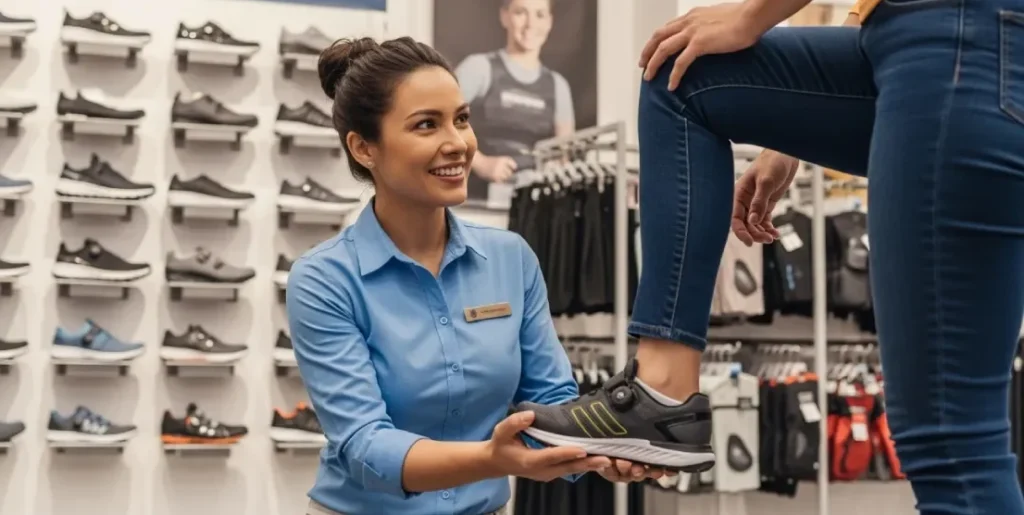
1. Test the Grip – Not Just the Look
Before buying, always flip the shoe and check the sole.
If it feels too smooth or plasticky, it may slide on bike pedals.
Rubber soles with grooves or patterns are usually better for grip.
In-store tip: Press your thumb on the sole — if it grips your finger, it’ll grip your pedal too.
3. Leave Room — But Not Too Much
While trying on, make sure:
- Your toes can move slightly, not touch the front
- The shoe doesn’t slip from the heel
- Your arch feels supported
📌 Rule of thumb: Leave a half thumb-width space between your toe and the shoe end.
5. Check for Weather Compatibility
- For hot climates, choose mesh or breathable uppers
- For rainy areas, avoid cloth shoes — go for synthetic or semi-waterproof designs
7. Easy to Clean = Long-Lasting
Choose shoes that don’t catch dust easily and are easy to wipe or clean.
This keeps the shoe looking fresh and increases its lifespan.
2. Try Shoes with Real Cycling Socks
Many customers try shoes barefoot or with thin socks in-store — but while cycling, they use thicker sports socks. This creates size issues later.
✅ Always wear the socks you’ll actually use for cycling during the fitting.
4. Think Long Ride, Not Just Short Try
Even if the shoe feels okay in a short try, imagine riding 10km. Ask:
- Will the material heat up?
- Will your foot slide?
- Is the tongue or lace pressing anywhere?
🛍️ Customers who test shoes with a 5-minute walk inside the store often make better decisions.
6. Don’t Go Over-Budget for Features You Don’t Need
If you’re a casual rider, you don’t need clip-in shoes or carbon soles.
Stick to what fits your ride, not just the brand name.
We’ve seen many customers return expensive cycling shoes because they weren’t practical for daily use.
Bonus Trick:
Ask your local store:
“Do you have shoes with pedal grip but still okay for walking?”
You’ll be surprised — many hybrid models aren’t displayed but kept in back stock!
In short
Buying cycling shoes doesn’t need to be confusing. With the right questions, a little testing, and a focus on comfort + grip — you’ll ride smoother and feel better.
We don’t just sell shoes, we help people ride smarter. 💬
FAQ – People Also Ask
1. Can I use regular running shoes for cycling?
Yes, you can for short casual rides. But for better grip, foot support, and pedaling efficiency, cycling-specific shoes or grippy sports sneakers are better.
2. What kind of shoes are best for beginners in cycling?
Beginner riders should look for breathable, rubber-soled sports shoes with good grip. Flat pedal shoes or sporty sneakers work great.
3. Do I need special shoes for cycling if I’m just commuting?
If you're riding to work or school daily, you don’t need pro shoes. Just choose lightweight, comfortable sneakers with non-slip soles.
4. Which shoes are good for long-distance cycle rides?
For longer rides, look for lightweight cycling shoes with stiffer soles and better arch support. Clip-in shoes (SPD) are great if you're using clip pedals.
5. Are cycling shoes different for men and women?
Not always. Many shoes are unisex. Just make sure the size fits right and the shoe feels supportive. Some women prefer slightly narrower fits.
6. Can I walk in cycling shoes?
It depends. Flat pedal shoes and hybrid cycling shoes are good for walking. Clip-in road cycling shoes are harder to walk in because of the cleats.
7. What’s the best sole material for cycling shoes?
Rubber soles are best for grip. Stiff midsoles (EVA, nylon, or carbon composite) give better pedal power for long or fitness rides.
8. How do I know if my cycling shoes fit properly?
Make sure there’s a thumb-width space at the front, no heel slippage, and the shoe feels snug but not tight. Try them with the socks you’ll ride in.
9. Do I need waterproof shoes for cycling?
Only if you ride in rainy or wet areas. For normal use, breathable mesh or synthetic uppers are fine.
10. What shoes do mountain bikers usually wear?
MTB riders often use flat pedal shoes with sticky rubber soles or clip-in MTB shoes for better control on trails.
11. Are expensive cycling shoes worth it?
Only if you ride often, race, or need high performance. For casual or daily riders, a well-built sports shoe or flat pedal shoe is enough.
12. Can I use sneakers for uphill or hilly cycling?
Sneakers with strong grip and firm soles can handle light hills. But for steep trails, use MTB shoes or trail-specific cycling shoes.
13. How can I check if a shoe will grip the pedals well?
Look for a rubber outsole with grooves or textured patterns. You can also press your thumb against the sole — it should feel tacky, not slippery.
14. Where can I buy good cycling shoes online?
You can check trusted websites like Amazon, Decathlon, Adidas, or your local footwear store’s online portal. Always read reviews and check return policies before ordering.
